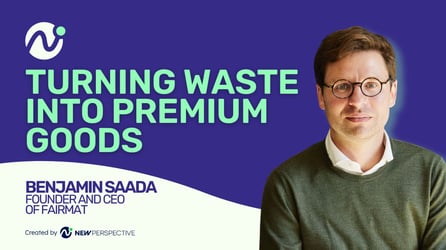Episode Info
For this episode of the Green New Perspective podcast we’re thrilled to welcome Nora Eslander, Head of Communications and PR of Renewcell.
Renewcell is a Swedish company promoting sustainability and circularity in the fashion industry. Its innovative technology recycles textiles into a high-quality dissolving pulp — circulose — used to make more textiles. This is a huge step forward towards true sustainability in fashion.
We talked to Nora about the challenge of implementing sustainable goals in fashion, the need to reduce waste and minimize the industry's environmental impact, and how Renewcell’s technology is helping to transform how we produce and consume clothing.
Renewcell on SoMe:
web: www.renewcell.com
IG: @renewcell
LI: @re-newcell
TW: @renewcellsweden
Watch the episode on YouTube
Interview with Nora Eslander, Head of Communications and PR of Renewcell.
.jpg?width=1280&height=720&name=SoMe%20Nora%20Eslander%20Ep%208%20(3).jpg)
Dunja Jovanovic: Can you tell us about the history of Renewcell and how you got it started?
Nora Eslander: Renewcell was founded back in 2012 by scientists at the Royal Institute of Technology in Stockholm, Sweden. They started to research a process for how to recycle cellulose in textiles. They wanted to figure out a way to save the textile waste that everybody else thought was waste, but they saw it as having great potential.
Together with some entrepreneurs, they founded the company back in 2012. It took years of research and development, but now we're a commercial-scale factory.
DJ: Can you explain Renewcell's technology? We don't have many textile-to-textile recycling companies today in the world.
NE: Renewcell’s technology recycles the cellulose in textiles. We take cotton and viscose textile waste and put it through a multistep process that turns it into a dissolving pulp, circulose. Circulose is basically pure cellulose — a raw material you can put back into the production of textile fibers and yarns and spun into a new fabric. We're producing raw material, but instead of farming cotton or cutting down trees, we use 100% textile waste.
DJ: How is your technology different from other textile recycling methods?
Nora Eslander: Our company is all about producing quality material. Our process separates fibers without shortening their length. Mechanical recycling methods shred the material and shorten the fibers. Shortened fibers can affect the end quality of the garment produced with those fibers.
Our process separates the fibers chemically and mechanically, allowing us to maintain the same quality as the raw material. This means that the next step, fiber production, results in the exact same fiber with no difference in quality, except for the way we produce the material.
DJ: How do you collect textile waste? Is it from textile factories or people, or both?
Nora Eslander: We source textile waste from both factories and people, but we don't do any sorting ourselves. We buy it pre-sorted from established sorting and collecting companies around the world. Currently, we source 95% to 99% cotton, with a tolerance for small percentages of other materials.
DJ: What are the biggest challenges that Renewcell has faced in terms of this technology?
Nora Eslander: Scaling technology is a perpetual challenge with distinct phases that each have unique difficulties. We've Made significant progress by moving from a laboratory scale to a demonstration scale, and have even constructed a pilot plant to produce at an industrial scale.
This was a major milestone: it demonstrated we could indeed produce at scales. Now we need to ensure the technology is stable at scale, and secure financing to build a factory.
DJ: How do you see your technology and the broader textile recycling industry evolving in the coming years? Are fashion companies interested in using circulose and willing to collaborate with recycling centers and cleantech companies on a larger scale?
Nora Eslander: The fashion industry is facing pressure to change its production methods from both regulators and consumers, and this demand has been on the rise in the past few years. There are some sustainable practices being adopted, but a lot more can be done.
Circularity needs to be taken more seriously. While the industry is focused on lowering CO2 emissions, other important issues — such as the exploitation of natural resources are being overlooked that have significant impacts on ecosystems.
For example, growing cotton or producing viscose can lead to deforestation and harm nature and ecosystems. Circularity and the use of other natural resources need to be given higher priority when it comes to improving industrial production processes.
DJ: Yes — and recently I found out that the fashion industry is currently responsible for 20% of industrial water pollution.
Nora Eslander: Water use, pesticides, and pollution are also major concerns. It’s true that the industry is responsible for a large part of industrial water pollution. While recycling polyester is important for circularity, it's also important to address the microplastic pollution that it can cause.
DJ: Can you talk about the issue of greenwashing in the fashion industry?
Nora Eslander: The conversation around greenwashing is crucial and timely, but it's becoming counterproductive. Ultimately, it all comes down to transparency. DJ: How do you think companies can tackle this issue?
Nora Eslander: Being transparent is crucial. It's vital to provide evidence that you're taking action and have data to support your claims. It's unproductive to communicate something that isn't actually happening.
However, on our side, it's also important to collaborate with larger brands, even though they face pressure from consumers. These brands have the influence and financial resources to create change that smaller brands can't. This is especially relevant when it comes to implementing new technologies.
Not to say that larger brands shouldn't be held accountable, but we should also recognize their efforts and encourage them to continue making progress. Focusing solely on blame and finger-pointing will only delay progress, and we don't have the luxury of time anymore.
DJ: Could you elaborate on how your brand communicates its mission and handles public image?
Nora Eslander: When we introduced circulose in 2019 as a product, it became much easier for both the market and consumers to comprehend our mission. While our primary customers are manufacturers of fibers and yarns, it is critical that we collaborate with brands and educate consumers about circulose to stimulate demand throughout the supply chain.
Our objective is to develop a sustainable and circular brand that designers will be eager to collaborate with, and consumers will be thrilled to wear and discuss. Sustainability has not traditionally been seen as attractive or exciting in the fashion industry, but we aspire to alter that perception with circulose.
DJ: Can you talk about any exciting new projects or initiatives that Renewcell has in the works?
Nora Eslander: We have a multitude of upcoming projects in various aspects of the company. I often mention to new colleagues that this is the perfect time to join us because of the exciting changes taking place, especially. in the past three years.
These include brand partnerships that aim to introduce circulose to the market and consumers. Product advancements, research and development will expand our capacity to replace more virgin materials with our products. We are also thrilled to be expanding our production and seeking ways to scale up to increase our impact.
DJ: Finally, how can people get involved with and support Renewcell's mission to create a more sustainable textile industry?
Nora Eslander: Can you buy clothes made of circulose from now on? No, I’m joking, obviously.
Your choices as a consumer carry tremendous power, but it's understandable to feel like your impact is small in the face of daunting global challenges. However, there's a reason to feel inspired. Major corporations are taking notice of consumers like you.
By demanding sustainable alternatives, you can help drive a shift in the market towards more eco-friendly options. Reflect on your consumption habits and make mindful choices. Remember: every small step towards sustainability counts!
Additionally, engaging with us on social media and spreading the message can help build our platform and foundation, so the brands we want to work with will acknowledge us.




